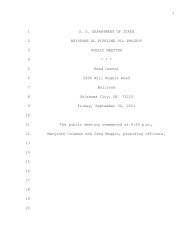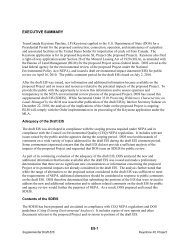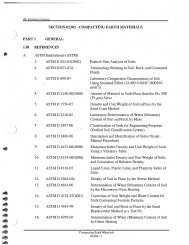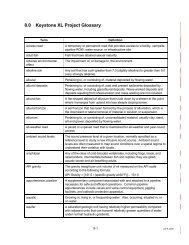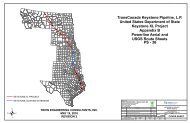2.1 Overview of the Proposed Project - Keystone XL pipeline - US ...
2.1 Overview of the Proposed Project - Keystone XL pipeline - US ...
2.1 Overview of the Proposed Project - Keystone XL pipeline - US ...
You also want an ePaper? Increase the reach of your titles
YUMPU automatically turns print PDFs into web optimized ePapers that Google loves.
Draft Supplemental Environmental Impact Statement<strong>Keystone</strong> <strong>XL</strong> <strong>Project</strong>materials to industry and consumers by all transportation modes, including <strong>the</strong> nation’s <strong>pipeline</strong>s.Through PHMSA, <strong>US</strong>DOT develops and enforces regulations for <strong>the</strong> safe, reliable, andenvironmentally sound operation <strong>of</strong> <strong>the</strong> nation’s 2.3-million-mile <strong>pipeline</strong> transportation systemand <strong>the</strong> nearly 1 million daily shipments <strong>of</strong> hazardous materials by land, sea, and air. WithinPHMSA, <strong>the</strong> Office <strong>of</strong> Pipeline Safety has <strong>the</strong> safety authority for <strong>the</strong> nation’s natural gas andhazardous liquid <strong>pipeline</strong>s. The proposed <strong>Project</strong> is included in <strong>the</strong> latter category.<strong>Keystone</strong> would be required to construct, operate, maintain, inspect, and monitor <strong>the</strong> proposed<strong>Project</strong> consistent with <strong>the</strong> PHMSA requirements presented in 49 CFR 195 (Transportation <strong>of</strong>Hazardous Liquids by Pipeline), as well as relevant industry standards, and applicable statestandards. These regulations specify <strong>pipeline</strong> material and qualification standards, minimumdesign requirements, and required measures to protect <strong>the</strong> <strong>pipeline</strong> from internal, external, andatmospheric corrosion. The regulations are designed to prevent crude oil <strong>pipeline</strong> accidents andto ensure adequate protection for <strong>the</strong> public.Pipelines that carry gasoline, diesel fuel, crude oil, or o<strong>the</strong>r hazardous liquids must implementadditional safety measures if <strong>the</strong>y cross a particularly sensitive area such as <strong>the</strong> source for amunicipal drinking water supply. <strong>Keystone</strong> would comply with a set <strong>of</strong> 57 Special Conditionsdeveloped by PHMSA for <strong>the</strong> proposed <strong>Project</strong> (see Appendix B, PHMSA 57 SpecialConditions). The Department, in consultation with PHMSA, has determined that incorporation <strong>of</strong>those conditions would result in a proposed <strong>Project</strong> that would have an improved degree <strong>of</strong>safety relative to typically constructed domestic oil <strong>pipeline</strong>s and a degree <strong>of</strong> safety along <strong>the</strong>entire length <strong>of</strong> <strong>the</strong> <strong>pipeline</strong> system similar to that which is required in high consequence areas(HCAs) as defined in 49 CFR 195.450. These Special Conditions cover four general categories<strong>of</strong> project activities:• Material requirements;• Construction requirements;• Operations and maintenance; and• Reporting, records retention, and senior-level certification requirements.The regulations are designed to help prevent crude oil <strong>pipeline</strong> accidents and to ensure adequateprotection for <strong>the</strong> public. Section <strong>2.1</strong>.7.1, Pipeline Design, presents <strong>the</strong> major <strong>pipeline</strong> designconsiderations <strong>of</strong> <strong>the</strong> proposed <strong>Project</strong>. Nearly all petroleum <strong>pipeline</strong>s in <strong>the</strong> United States areburied, and <strong>Keystone</strong> has also proposed to bury <strong>the</strong> proposed <strong>Project</strong> <strong>pipeline</strong>. In addition, <strong>the</strong>Special Conditions provide more stringent requirements for many <strong>of</strong> <strong>the</strong>se design factors. Incomparison to an aboveground <strong>pipeline</strong>, burying a <strong>pipeline</strong> reduces <strong>the</strong> potential for <strong>pipeline</strong>damage due to vandalism, sabotage, and <strong>the</strong> effects <strong>of</strong> o<strong>the</strong>r outside forces, such as vehiclecollisions.<strong>Keystone</strong> prepared a draft CMRP that is included in Appendix G. That plan describes <strong>the</strong>construction methods and environmental protection measures that <strong>Keystone</strong> committed to inorder to reduce <strong>the</strong> potential construction impacts <strong>of</strong> <strong>the</strong> proposed <strong>Project</strong>. The CMRP includesspecific techniques or mitigation measures to address sensitive areas such as highly erodiblesoils, shallow groundwater, and o<strong>the</strong>r conditions. If <strong>the</strong> proposed <strong>Project</strong> is issued a PresidentialPermit, <strong>the</strong> CMRP would be updated after <strong>the</strong> Record <strong>of</strong> Decision is issued to reflect anyadditional conditions included in <strong>the</strong> Record <strong>of</strong> Decision and in o<strong>the</strong>r permits issued to <strong>Keystone</strong>,and to reflect regional construction considerations.<strong>Project</strong> Description <strong>2.1</strong>-34 March 2013



